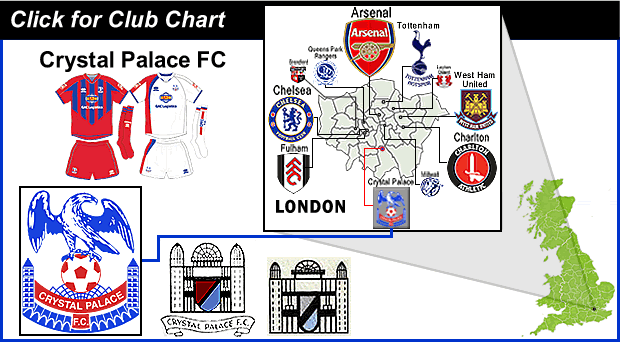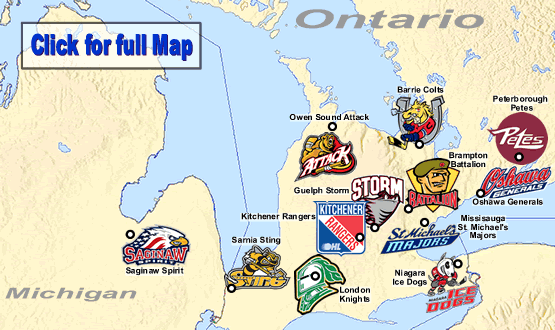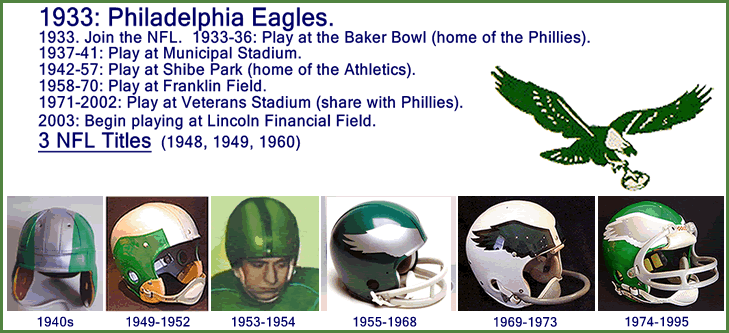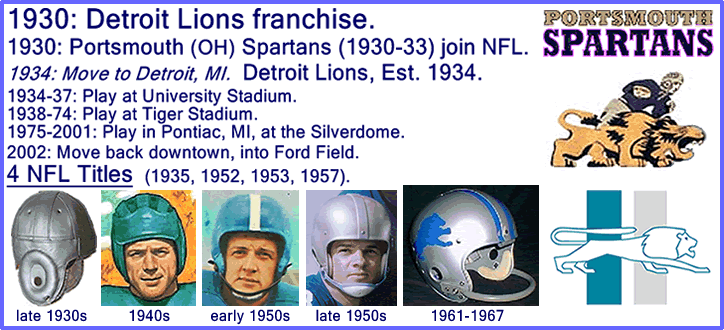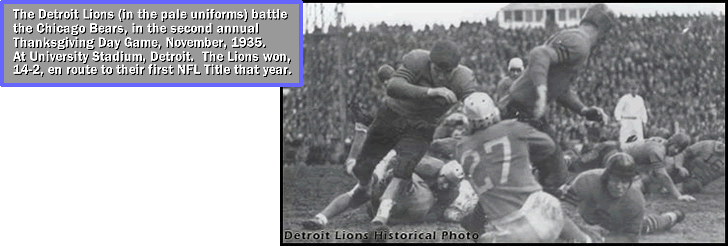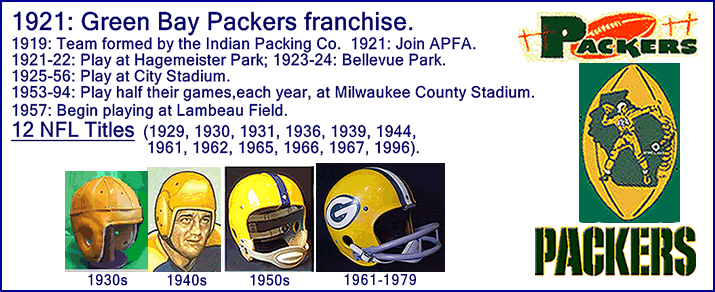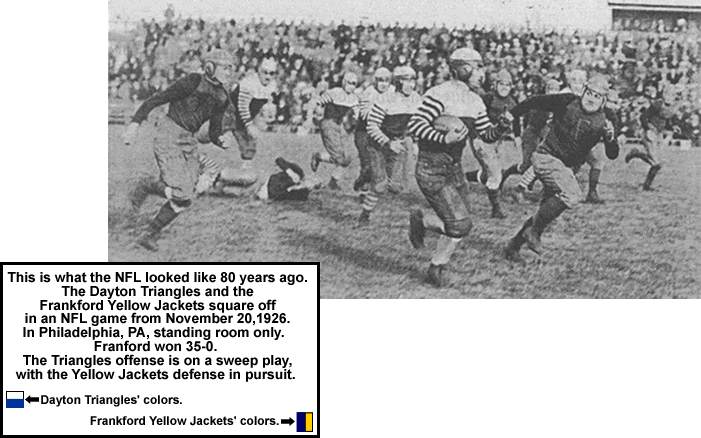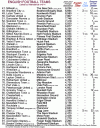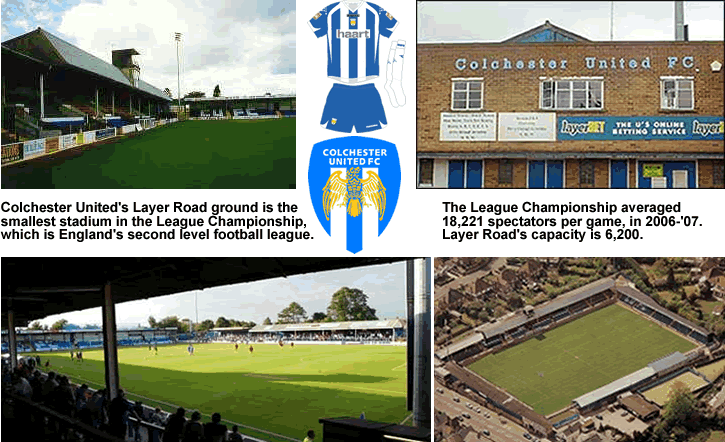
…
…
The St. Louis Rams have a convoluted history. The NFL Rams’ franchise played 8 seasons in Cleveland, OH; 49 seasons in Los Angeles/Orange County, CA, and are currently [2011] playing their 17th season in St. Louis, MO. [Update, January 2016: after 21 seasons in St. Louis, the Rams franchise has moved back to Los Angeles, effective for the 2016 season, where they will play in the Los Ageles Coliseum (once again), for a projected 2 seasons, until the new stadium in Inglewood is built for the 2019 season - see this, NFL Returns to Los Angeles With Rams & Sleek Stadium (by Keith Flamer at forbes.com).]
The Rams’ NFL franchise traces its roots to the Cleveland Rams of the short-lived AFL (II) of 1936-37. This 6-then-8-team league lasted just 2 years. Attorney Homer Marshman founded the Cleveland Rams in 1936. His general manager Damon “Buzz” Wetzel suggested their nickname, after the Fordham (NY) Rams college football team (his favorite team). Like the Fordham Rams, the Cleveland Rams originally wore red and black (in the AFL in 1936, and in their first season in the NFL in 1937). After the Rams’ 1936 season in the AFL (II), where they finished in second place to the Boston Shamrocks, Marshman learned of the NFL’s intention of expanding for the 1937 season, and his bid was selected over bids from groups in Los Angeles and Houston (the NFL wished to keep its teams, at that point in time, in a concentrated area of the Northeast and the Upper Midwest). So the Cleveland Rams bolted from the AFL (II), after the 1936 season, and the Rams joined the NFL as an expansion team, while that AFL lasted one more season (1937), and folded. No front office or coaching staff, and just four 1936 Rams’ players made the jump over from the AFL of 1936 to the Cleveland Rams of the 1937 NFL. {See this photo of Mike Sebastian, William “Bud” Cooper, Harry “The Horse” Mattos, and Stan Pincura (the four members of the original AFL-mark-2 Cleveland Rams team [1936], who joined the new NFL Cleveland Rams team in 1937).} The NFL considers the AFL (II) (1936) version of the Cleveland Rams to be a separate entity.
The Cleveland Rams joined the NFL’s Western Division in 1937, making the league a balanced 10-team league again, and filling the gap left by the Cincinnati (football) Reds, who were an expansion team in 1933 (along with Pittsburgh and Philadelphia), but folded midway through the following season (1934). The Cleveland Rams played their first 2 NFL seasons in the cavernous Cleveland Municipal Stadium, but were barely able fill even a fraction of it. The club had a very poor first season, going 1-10. The next season they changed their uniforms to navy blue and yellow-orange; they finished 4-7. In 1939, the Cleveland Rams began playing in dark royal blue and yellow-orange, which would become the colors of the Rams’ franchise from 1939 to 1948, from 1950 to 1963, and from 1973 to 1999 (51 seasons). [The St. Louis Rams have been wearing navy blue and metallic gold since 2000.] The Cleveland Rams organization had a shaky start in the NFL, even playing in a high school football stadium for a while (in 1938, at Shaw Stadium in East Cleveland). They played at Municipal Stadium in 1936 and ’37, from 1939 to ’41, and in December 1945 in the NFL Championship Game. For some games in 1937, and for the 1942, 1944 and ’45 seasons, the Rams played mostly at League Park (which was home of the MLB team the Cleveland Indians from 1901 to 1946). The Cleveland Rams were forced to remain dormant for the 1943 season due to lack of players, because of World War II. The team never had a winning season until UCLA phenom Bob Waterfield was drafted by the team in early 1945. For the 1945 season, Warfield immediately started as quarterback. He also handled kicking and punting duties, as well as playing defensive back (with 20 interceptions in 4 years). Waterfield led the team to a 9-1 record, and they faced the Washington Redskins in the 1945 NFL Championship Game. The Rams beat the Redskins 15-14, on a frozen field, at the Cleveland Municipal Stadium, with Waterfield throwing touchdown passes of 37 and 44 yards. But the margin of victory was the 2 point safety that was awarded to the Rams, after a Redskin pass attempt in their end-zone struck the field goal crossbar, and fell to the ground. {1945 NFL Championship Game.} Bob Waterfield was voted the league’s Most Valuable Player for 1945. That was the first time in the NFL that a rookie won the honor.
The 1945 title game was the last game the Rams played in Cleveland. Their owner at the time, Daniel Reeves, claimed the team had lost $40,000 that year, despite winning the title. He was also threatened by the presence of a Cleveland team in the nascent All-America Football Conference (1946-1949). This league was formed in late 1944, but put off playing the 1945 season because of World War II. By late 1945, it was becoming apparent to the Rams management that this new AAFC team, to be called the Cleveland Browns, would put a dent in the already thin Rams’ fan support. Reeves began talking to the city of Los Angeles about playing at the 90,000 seat Memorial Coliseum. In January 1946, the Cleveland Rams moved west to California. When the Los Angeles Rams began play in the fall of 1946, they became the first major-league team in America to set up shop west of St. Louis, Missouri. Which is ironic, because 48 years later, the franchise would move to St.Louis.
The Los Angeles Rams ended up as trailblazers on another front, as well. Because the Memorial Coliseum commissioners stipulated that as part of the lease agreement, the Los Angeles Rams must be integrated. So the Rams signed two black UCLA players, Kenny Washington {see this}, and Woody Strode {see this}. The Los Angeles Rams played at the 90-to-100,000-capacity Memorial Coliseum from 1946 to 1979 ( 34 years).
And the Los Angeles Rams were trailblazers on yet another front…In 1948, Rams halfback and off-season commercial artist Fred Gehrke painted the team’s helmets with a set of ram’s horns. This became the first example of an insignia on the helmet of a pro football team. You can see an illustration of Gehrke’s 1948 LA Rams helmet, as well as all the helmet designs of the NFL Rams below. Here is an excerpt from the ‘Fred Gehrke‘ page at en.wikipedia.org…
{excerpt}…’In the mid-1940s Gehrke toyed with the notion of painting a football helmet. Rams coach, Bob Snyder suggested that Fred paint a helmet with the ram horns on it that he could present to the team’s owner Dan Reeves. Fred painted two ram horns on an old college helmet and presented the design to Reeves, who was intrigued by the design. Reeves then contacted the NFL for a ruling on legality of having a football helmet painted. It was reported that the answer Reeves received from NFL was “You’re the owner; do what you want!” Reeves then tasked Gehrke to paint 75 helmets at $1.00 per helmet. The project took Gehrke the entire summer of 1948. The newly painted helmets debuted during a pre-season match-up between the Rams and Redskins at the Los Angeles Coliseum before a crowd of [77,000]. Upon seeing the new helmets the crowd began cheering which was followed by a five-minute standing ovation. To this day, Gehrke’s rams horn logo is still worn by the team.’…{end of except}.
Here is a good article on Gehrke and his designing of the Rams helmet logo, from Sports Illustrated, from Sept. 5 1994, by Mark Mandemach, ‘Rembrandt Of The Rams
Fred Gehrke got out his brushes and changed helmets forever‘ (sportsillustrated.cnn.com/vault).

Photo and Image credits above -
helmethut.com/leatherram.
toddradom.com/athletes-as-artists-andrew-mccutchen-and-the-1948-la-rams.
gridiron-uniforms.com/1948.
profootballhof.com/history/infographic-wednesday.
…
Below, courtesy of GridironUniforms.com, here is a helmet history of the Cleveland/Los Angeles/St. Louis Rams that I put together…

Above: Helmet illustrations from: gridiron-uniforms.com/
The Los Angeles Rams were about to enter their glory days. They ended up playing in four NFL Championship Games between 1949 and 1955. And though they only won one NFL title in this period, in 1951, the greatness of this team cannot be diminished. Wide receivers Elroy “Crazy Legs” Hirsch and Tom Fears were the Rams two big offensive weapons. Bob Waterfield, and from 1950 on, Norm Van Brocklin, both helmed the squad at quarterback. For a while the two worked in tandem, which is unheard of in pro football. To say the team emphasized the passing game would be an understatement. In 1950, the NFL began allowing unlimited substitutions, and the Rams exploited the rule change. The 1950 Rams ended up averaging an all-time NFL record 38.8 points per game that season {see this post on the 5 highest scoring teams in NFL history}. Their wide-open offense proved so popular that the Rams became the first pro football team to have all its games televised. Despite their local television deal, the LA Rams of the mid-to late 1950s still drew extremely well. In 1958, for example, when the Rams went 8-4, they averaged 83,680 per game (6 games), including 100,470 for the Chicago Bears and 100,202 for the Baltimore Colts.
Below, the Rams’ first star, QB/K/P/DB Bob Waterfield – Photo on left: seen with his high school sweetheart and wife of 20 years, the film star Jane Russell. Photo in middle: Waterfield seen charging down the sideline for a 13-yard touchdown run versus the [now-defunct] Baltimore Colts of 1951, at the Los Angeles Memorial Coliseum on Sunday, October 22, 1950 – final score Los Angeles Rams 70, Baltimore Colts 27 {boxscore from pro-football-reference.com, here}. At right is an [unattributed] illustration of Bob Waterfield in his 1948 LA Rams uniform (but with a 1950 Rams’ jersey {thanks for catching that, Tony A! [see comment #8, below in the Comments section]})….

Image credits – findagrave.com. ’100 Greatest Quarterbacks in NFL History Part II: 50-21‘ (bleacherreport.com). http://store03.prostores.com/servlet/dcbcollectibles/the-Football-Collectibles/s/496/Categories
There were two other successful periods for the Rams in Los Angeles. In the mid-to-late 1960s, the Rams featured the Fearsome Foursome, the great defensive line of Rosey Grier, Merlin Olsen, Deacon Jones, and Lamar Lundy. The 1967 Rams, who were led by head coach George Allen, went 11-2-1, and became the first NFL team to draw over a million spectators in a season (14 games [ie, home and away gate figures combined]). In 1969, Allen hired a 33-year old Dick Vermeil to be the NFL’s first-ever special teams’ coach; the Rams went 11-3 that year. But these Rams were never able to win in the playoffs. And the next good Rams teams, of the mid-to-late 1970s (who were coached by Chuck Knox) had the same problem, losing in the NFC Championship Game 4 times in 5 seasons (1974-76; 1978). The Los Angeles Rams did make it to the Super Bowl – once – in the 1979 season, but lost to Pittsburgh 31-19 in Super Bowl XIV.
In 1980 the Rams moved south-east of the Upton Park neighborhood of south Los Angeles (where the Coliseum is located), to Anaheim, Orange County, CA and Anahiem Stadium (home of the MLB team the California Angels). The Rams needed a smaller stadium, because the dreaded blackout rule was killing them – they couldn’t come close to selling out the then-93,000-capacity Coliseum, so their product was being diminished in their home town because games were being blacked out. The solution was a smaller venue. The Rams played at the 69,000-capacity Anaheim Stadium for 15 seasons (1980-94), but that situation never really worked out for the Rams (or, actually, for the Angels as well, because the renovations made at the stadium to accommodate the Rams ruined the atmosphere for baseball games there, and after the Rams left, the Angels pretty much gutted the stadium and returned it to the respectable, mid-40,000-capacity ballpark it originally was). By the early 1990s, the Rams were foundering, both on-field and with respect to waning fan interest and another inadaquete stadium situation. They found that neither Orange County nor the city of Los Angeles was willing to build a new stadium, and, true to the tenor of the times, the Los Angeles Rams became yet another NFL team in the first half of the 1990s that openly courted other cities (to get a free stadium). Baltimore, MD was first sought after (Baltimore would steal the Browns from Cleveland soon after, in 1995/96), but that deal fell through.
The city of St. Louis, now 7 years without an NFL team, stepped up with a sweetheart deal, and the Rams moved back east, to St. Louis, Missouri. The St. Louis Rams did not change their uniforms at all when they first moved to Missouri (they did do an overhaul of their gear in 2000 [right after they had won the Super Bowl], switching to navy blue and turning their rams’ horns and trim color from yellow-orange to metallic gold). For the first half of the 1995 season, the Rams played at Busch Stadium (II), then moved into the publicly-financed Trans World Dome in November 1995 [the stadium is now called the Edward Jones Dome].
The Rams continued their lackluster form until ex-Eagles coach Dick Vermeil came out of retirement, returning to the Rams’ organization and taking the Rams’ head coach job in 1997. The Rams of this era became a very high-powered offensive force that featured WR Isaac Bruce and RB Marshall Faulk (Hall of Fame, 2011) and were led by a QB, Kurt Warner, who came out of nowhere – from the Iowa Barnstormers of the now-defunct Arena Football League. Warner went from stocking supermarket shelves to hoisting the Super Bowl trophy in 5 years flat. In the 1999 season, in Super Bowl XXXIV [39], the Rams beat the Tennessee Titans by a score of 23-16, with the final touchdown a 73-yard completion from Warner to Bruce, and with the win clinched by a last-second, one-yard-line tackle by Rams’ linebacker Mike Jones on Titans’ WR Kevin Dyson {see this ‘Final play of Super Bowl XXXIV‘}.
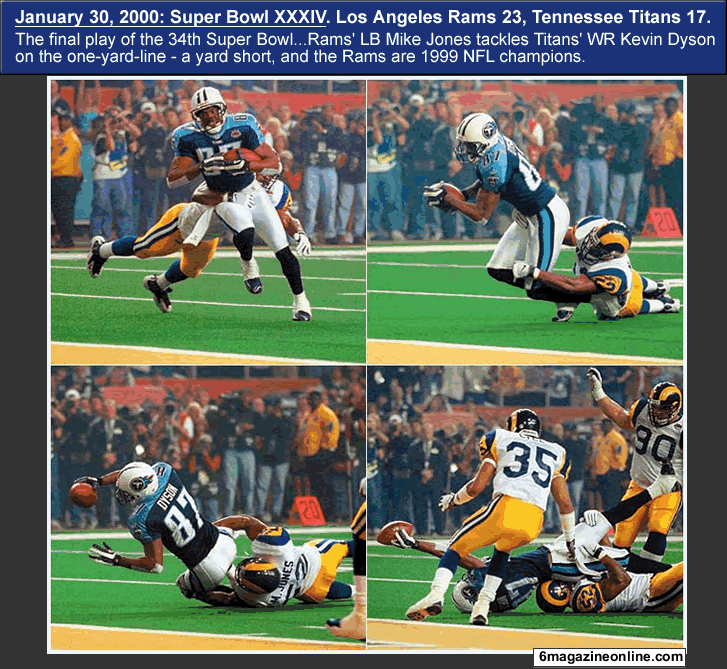
Photo credits – unattributed at 6magazineonline.com, ‘Top 10 NFL games of the 2000s‘.
The Rams won 2 NFL Championship titles (1946 [as the Cleveland Rams], 1951 [as the Los Angeles Rams]).
St. Louis Rams: 1 Super Bowl title (1999).
The Rams are 1-2 in Super Bowl appearances [losing to the Steelers in the 1979 season, and losing to the Patriots in the 2000 season].
_
Thanks to the contributors to the pages at en.wikipedia.org, ‘NFC West‘.
Special thanks to Tim Brulia, Bill Schaefer and Rob Holecko of the Gridiron Uniforms Database, for giving billsportsmaps.com permission to use images from their gridiron uniform database.
